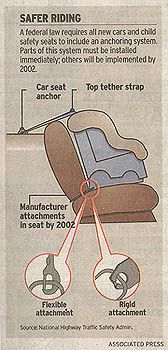| SEATBELT.COM |
[an error occurred while processing this directive]
|
|
EVERYONE
DESERVES TO BE SAFE ON THE ROAD
|
|
|
Search |
The Road to Safety: Child Car Seats
ASSOCIATED PRESS The change is part of a three year federal plan to create a universal, easy-to-use child-seating system. The goal is to eliminate the confusion among parents that results in the incorrect installation of up to 80% of car seats. Once all autos and seats have the new system, the government estimates it will save up to 50 lives and prevent 3,000 injuries a year. While there are hundreds of thousands of child seats already in use, parents should not abandon them. Seat manufacturers and automakers are offering kits to add the tethers and new attachment points to existing seats and cars. Experts believe that existing seats are safe when installed properly, but the new regulations are needed to simplify that task. "Currently, it varies from seat to seat and vehicle to vehicle what type of restraint system you have," said Steve Oesch, senior vice president of the Insurance Institute for Highway Safety, an industry-backed research group that supports the change. Starting today, the safety administration is requiring that automakers do their part by beginning to equip new cars with anchor points for the top tether straps. On Monday, Jim Hall, chairman of the National Transportation Safety Board, asked states to get moving on setting up fitting stations where parents can have child restraints installed and checked. So far, two are doing so, New York and South Carolina. While Oregon does not have such fitting stations yet, the state's Child Safety Seat Resource Center put on 59 free clinics throughout Oregon with the help of local fire, health and police departments. For a list of upcoming clinics, check the Oregon Safe Kids Web Page at www.osp.state.or.us/safekids and click on the "events" icon. The safety administration said people with questions about the new system should call their seat's manufacturer, the maker of their automobile or NHTSA's auto safety hot line at 888-DASH-2-DOT (888-327-4236). Information is also available via the internet at www.nhtsa.dot.gov/people/injury/childps. |
